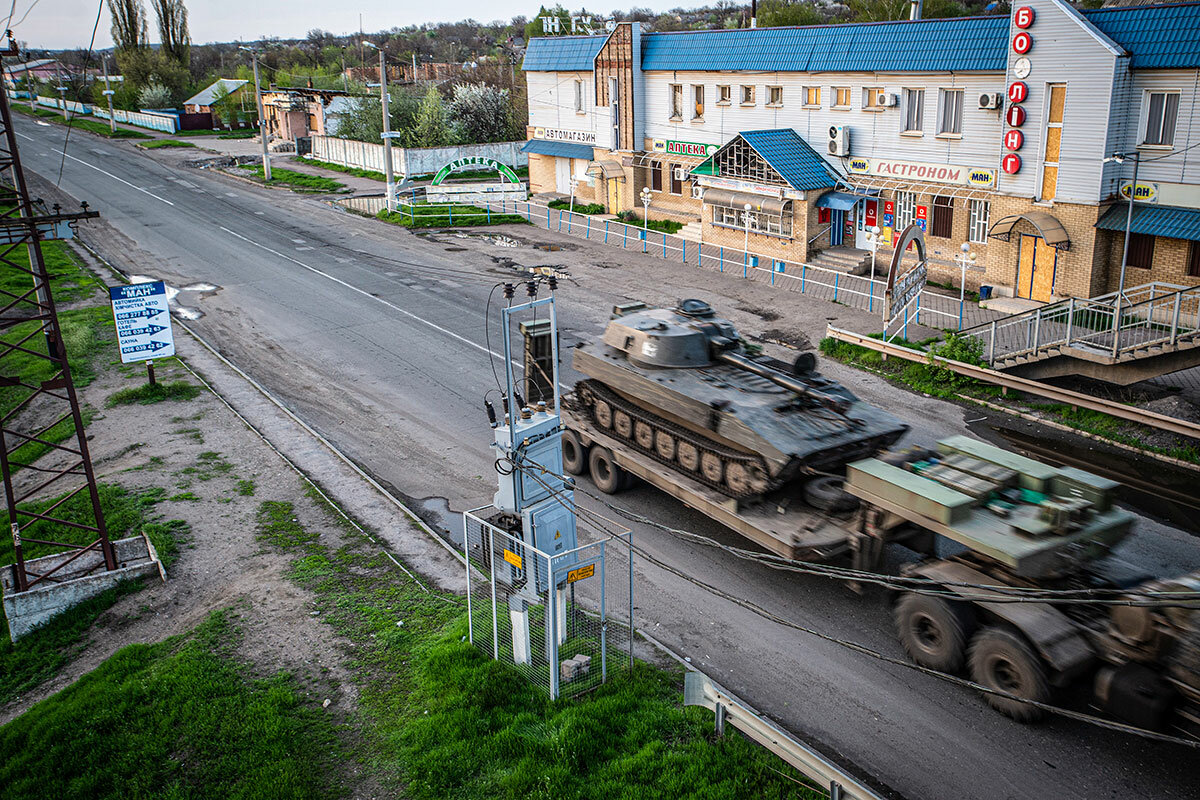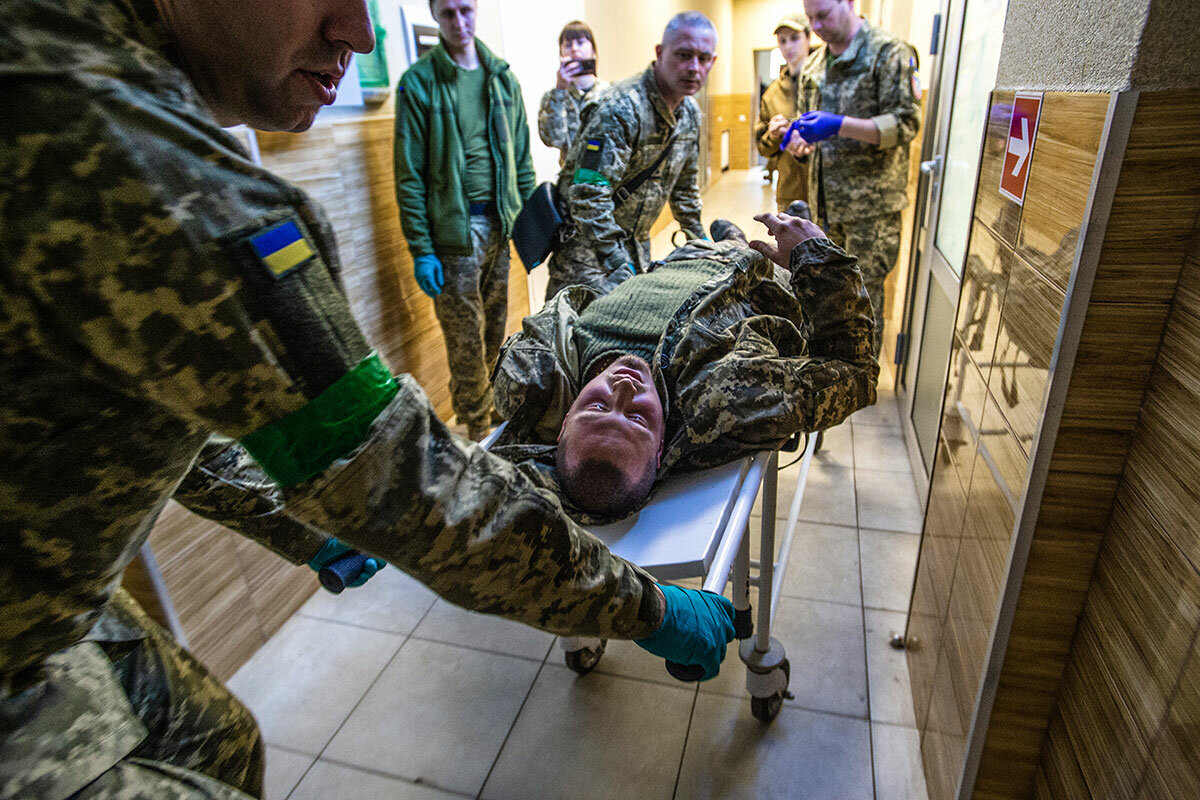Russian war’s ‘Phase 2’: How Ukraine troops adapt, giving little ground
Loading...
| SLOVIANSK and KRAMATORSK, UKRAINE
The Ukrainian artillery team was moving into position in the northern Donbas region, along the front line near Izium. The soldiers did not even have time to orient their guns before they were found by a Russian drone.
The first Russian 152 mm shells – fired by howitzers more than 10 miles away – landed near the Ukrainian guns. As the artillery team ran for safety, its vehicle was hit and set on fire.
The driver, badly wounded, veered straight into bushes as shells rained down. The survivors escaped on foot, across open fields.
Why We Wrote This
As Russia refocuses its war effort on the Donbas, it’s applying lessons learned from its initial offensive. To endure, Ukrainians, too, must call on different reserves – of resolve and patience.
Roman, a young artilleryman with a short patchy beard, recalled the events from a darkened military hospital room in Kramatorsk, his eyes glazed and an intravenous drip in his left arm, as he recovered from blast concussion. He gave only his first name, in keeping with Ukrainian military rules for wounded soldiers.
The biggest surprise for him? “That I am still alive here, after that shelling,” he says listlessly, closing his eyes and lying back on his bed.
Roman’s story, recounted last Friday, is emblematic of the new focus, style, and demands of the war in Ukraine, in what Russia calls Phase 2 of its invasion.
Since mid-April, Russia has re-concentrated on conquering the industrial heartland of the Donbas, made up of the eastern regions of Donetsk and Luhansk, where Russian-backed separatists have fought Ukrainian forces for eight years.
The new battlefield has required that Ukrainian forces demonstrate resolve, patience, and renewed confidence – the latter born of already defeating the Russian advance on the capital, Kyiv – as they seek to hold their ground despite Russia’s numerical superiority and overwhelming firepower.
Russia has escalated its shelling in an apparent bid to advance on the eastern region both from the Izium axis in the north and up from Kherson and Zaporizhzhia in the south. The pincers movement seeks to cut off some of Ukraine’s most battle-hardened forces – and perhaps enable Moscow to declare some gains before its annual May 9 Victory Day military parade at the Kremlin, which celebrates its defeat of German forces in World War II.
Roman’s story of survival may be a surprise for Russia, too. Ukrainian forces have given up little ground despite the intensified bombardment along eastern Ukraine’s entire 300-mile front.
In Roman’s unit the driver is dead, the commander is in intensive care, another artilleryman has shrapnel wounds, and the rest are concussed, like Roman.
Yet he says that despite the “really incredible” numbers of Russian shells, “the enemy is stopped, and they cannot advance because we are defending ourselves; we are holding our lines.”
Race against time
In many ways, the fight for the Donbas is a race against time: Can entrenched Ukrainian forces withstand the unrelenting onslaught until enough extra American and European military hardware arrives to help thwart the Russian advance, and potentially mount a counterattack?
Both sides have drawn lessons from Russia’s failed advance in late February on Kyiv, where a 40-mile-long convoy of Russian armor was smashed by stealthy Ukrainian anti-tank teams and precise artillery and drone strikes. That forced Russia to withdraw, and at least suspend its ambition to occupy all of Ukraine.
By contrast, in the Donbas – where much of the fighting is in flat, open fields, unlike the forested ground around the capital – Russian troops have advanced incrementally, in smaller groups, and always after relentless bombardment.
“Their artillery never, never stops,” says the deputy commander of Ukraine’s Donbas Battalion, a major who only gave the nickname Kot (Cat). He spoke in Sloviansk with a balaclava covering his face, as an air raid siren wailed across the city.
“They are changing their strategy, but it is still what we would expect from Russia,” says Major Kot. There are no more long, vulnerable columns: “They are sending recon units, then shell with artillery, and then send tanks,” he says. “If those tanks are destroyed, they send more tanks.”
Infantry hardly plays a role. “You see how many of them have died already, and they are not motivated,” says Major Kot. “Russia underestimated us; they don’t know how much we have been preparing.”
Russia’s battlefield pressure may be improving Ukrainian capabilities.
“Of course, shelling has intensified ... but the Ukrainian army is also getting more experienced; they know how to fight, how to protect our people, and are getting better at defending,” says Maj. Stepan Andriytsiv, director of a brigade medical unit with a Ph.D. in medical science, who is now at the Kramatorsk hospital.
The Ukrainian military admits its recent losses in the east have been “significant,” but claims that Russian casualties have been “colossal.”
Russian advances “slow and uneven”
The United States assessed last week that Russian troops were making “slow and uneven” progress in the Donbas, often of no more than “several kilometers ... on any given day, just because they don’t want to run out too far ahead of their logistics and sustainment lines,” one senior U.S. official told journalists.
But in its daily reports, the Institute for the Study of War noted that Russian forces made no confirmed ground attacks on Monday or Tuesday. It said a Ukrainian artillery strike April 30 on a Russian command headquarters near Izium has slowed the Russian push, and noted that, farther north, a Ukrainian counterattack Monday pushed Russian forces back 25 miles east of Kharkiv.
President Joe Biden called last week for Congress to approve a further $33 billion in military aid to Ukraine, much of it for the kind of weaponry meant to defeat Russian artillery and rocket attacks. Among other contributions, Germany in recent days said it would also send seven of its top-line 155 mm howitzers, which have a range of 25 miles.
“We really have a lack of heavy artillery,” says Ukrainian Sgt. Viktor Davydov, still wired and speaking quickly of Ukraine’s needs, after returning to the town of Druzhkivka from the front, where he says Russian artillery strikes continue “24/7.”
“When Russia sends incoming 200 shells, we send back 10 shells,” says Sergeant Davydov, who wears sunglasses, a pistol on his thigh, and a skull shoulder patch in the blue and yellow colors of the Ukrainian flag.
His job is to take freshly mobilized men to the front “to show them not to be afraid,” and to teach them “how to dig in and make very effective defensive positions” to compensate for the firepower imbalance with Russia.
“I tell them that all they have to do is hold our line, and not retreat,” says Sergeant Davydov. The cost can be high. The sergeant recalls 10 recruits in late April being sent to him one night at 11 p.m. By 6 a.m. two were dead and three wounded by Russian artillery.
At the Kramatorsk hospital, stretchers line the wall where wounded soldiers are brought from the front, and the facility generator and windows are sandbagged. Major Andriytsiv speaks during a pause in the arrival of casualties, as shells explode in the distance.
Despite the surge in Russian attacks, the number of wounded rose just 10% from March to April, the doctor says.
“Every day of us fighting and resisting Russian aggression makes the Ukrainian army and the Ukrainian nation stronger – every day,” he says.
Russian military surprises
But Russian forces have been learning, too, and the stories of wounded Ukrainian troops now often include a Russian military surprise.
Tank driver Maksym, for example, sits quietly in a hospital bed, eyes vacant, his tank battalion tattoo on his arm, and the Russian tank ambush that left him concussed occupying his thoughts.
His unit entered a small village, expecting two Russian tanks and an armored personnel carrier, but instead found 10 Russian vehicles.
“We were ambushed. ... The Russians were ready,” recalls Maksym. When he first saw the Russians, they were less than 70 yards away. “For tanks, it’s very close,” he says. His tank took a direct hit, but was robust enough to escape and rescue another crew whose tank was wrecked.
Also surprised was Serhii, a machine gunner in the Territorial Defense Forces. Both his legs are now in casts below the knee, after being peppered by shrapnel when his unit was struck by Russian artillery while trying to dig deeper trenches.
“We were trying to make a better position,” says Serhii, who was a worker in a carbon fiber factory and also fought in the Donbas in 2015. Serhii was wounded by the first of three Russian shells, which landed without warning Friday. Another man was struck in the back. But the Ukrainian position remains.
“I am not a military expert, but I think that our boys will hold the line,” he says.
Many Ukrainians stationed at the front expect more will be achieved.
“Everyone is in the mood to push the Russians all the way out,” says Oleksandr Tsunenko, a coal mine mechanic who has been home from the Donbas front just one day in the past 11 months.
“Why are they shelling us with rockets and artillery, and not moving forward?” asks the soldier with a worn assault rifle and fingernails dirty from the front. “They know if they advance, they will be defeated – that’s why they are afraid.”
Reporting for this story was supported by Oleksandr Naselenko.









